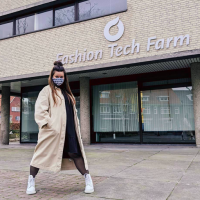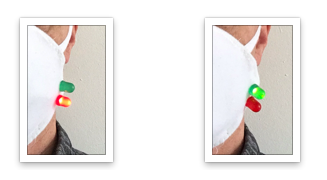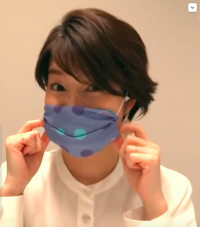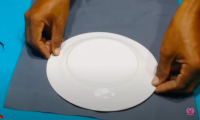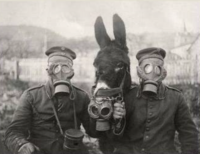Interactive face mask
in progress - beam
intro
I started looking for tutorials for making face masks a few weeks ago. Not surprisingly...
The face mask in the Netherlands is not obligatory. In other countries it is.
The main first goal for wearing the mask is protection.
From the visual to the fashionable
The face mask as a product worn by people is having a great impact on the visual aspect of the face, which is one of the most expressive parts of the human being.
The mouth is invisible, you cannot see anymore if the person is smiling or getting angry, shouting, being cynical.
The "product" as being a visible item on the body also has it "fashionable" sides: https://www.labeledby.com, initiated by Marina Toeters in the "Fashion Technology Farm".
e-textile
Both the Marina Toeters group and I and no doubt many others, are thinking on how e-textiles could be integrated inside the mask.
Recursive effects
The face mask has many implications...it might seem a simple protective measure, but it is also psychological: you might think to be safe with a mask - and you might, by wearing a mask and go out, think you are safe instead of staying at home. Thus wearing a mask might induce reckless behavior, increasing the risk, for yourself and others. These is called recursive effects. It makes life interesting, showing there are no simple solutions.
An early try out
A super simple sketch, to get some ideas about how this looks, and what the consequences might be.
There are two LED's (these "big" LED's), one red, one green, indicating infected or not. It could also indicate: green - I have had the disease, I am immune, red: I didn't get the infection yet.
Some questions:
- Technical: can we measure infection directly (no, virus is too small).
- Semiotics: Is the meaning of the "red" and "green" clear? (now as shown above, red can mean danger, I am sick, but also I am still not immune, quite ambiguous.
- Societal: if you are walking around with a mask with a red LED on, while you be lynched by a mob?
- Hygiene: the mask has to be changed and washed several times a day, what about the electronics?
product
The shape of the mask is interesting because this is for once NOT a box or rectangular. It should fit around our head and is in principle a single curved surface.
Some mask are very flexible and will fit always, but some mask are more stiff.
When you try a more stiff mask on it turns out that your head has a different shape than the head the mask was intended for.
When I was making a fabric mask, which looks simple, it became suddenly more complex. The shape from the downloaded example was clearly not having the idea that I have a nose. (Never thought of my nose in that way.) This means the curved shape has to be designed further, to accommodate for my nose...
e-textiles
What are the possibilities thinking from e-textiles - which interactivity could be added.
Sensors
Probing the possibilities:
- temperature sensor - makes sense, although microcontroller temperature sensors cannot measure your temperature sufficiently accurate.
- gas/pollution sensor - makes sense, although your breath is usually having a higher CO2 rate.
- light sensor - what purpose?
- humidity - measuring the quality of your breath?
- air pressure - what purpose?
Temperature sensors
- NTC Thermistor - http://interactionstation.wdka.hro.nl/wiki/Thermistor
Pollution sensors
- MQ series, bulky, using a lot of energy (heater) and quickly damaged - https://playground.arduino.cc/Main/MQGasSensors/
Integrated sensors
- BME680 temperature, humidity, air pressure and gas - https://www.adafruit.com/product/3660
Connectivity
Bluetooth connection to your smart phone. The microcontroller in the mask can have information, for example from the apps tracing people and seeing if your were in contact with a person later to be identified as having the infection.
making folding
Many tutorials can be found (suddenly). This Japanese one is charming: Japanese handkerchief: https://www.youtube.com/watch?v=PGug3ZZPp_k
This person is using a plate as the starting shape: https://www.youtube.com/watch?v=QeISPP2b_vg
properties
There are many face masks or masks, from just a piece of cloth to very protective ones, with special filters, right through to the military masks, originating probably in WW1. In WW1 poisonous gas was released inside the tranches, leading to the most terrible wounds of the soldiers. Because they still used horses and donkeys, also these animals got masks.
We as civilians use fabric masks, the experts don't agree on the effectivity of fabric masks for protecting us against infection of COVID-19.
Types of masks
- N95 Respirators
- Surgical Mask
- fabric DIY masks
- others (to be investigated)
- etcetera
studies
Suddenly all kinds of studies can be found about the effectivity of face masks.
A general introduction: https://www.youtube.com/watch?v=v93rcPkFkZc, discussion about pro's and con's of different types of masks.
AN example of a comparison of two types of masks:
The Surprising Truth About N95 Respirators VS Surgical Mask: https://www.youtube.com/watch?v=ftZy5s-klUA
You learn about the filters - this means that a simple "fabric" is not enough!
As usual, now there is an avalanche of people discussion the masks, even the big experts and virologists are not agreeing about the effectivity for civilians to wear the masks.
DIY
People are inventing very strange ways to protect themselves: https://www.sadanduseless.com/corona-virus-masks/
These ideas show really great resourcefulness and many ways to use materials in a "new" way.
ideas
Thinking on and having the BBC Microbit on my table, I thought of the possibilities of showing a scrolling text on the mask.
Also the microbit has Bluetooth built inside, so it can be connected quite simply to other microbits on other masks, and (relatively less simple) to a smart phone.
